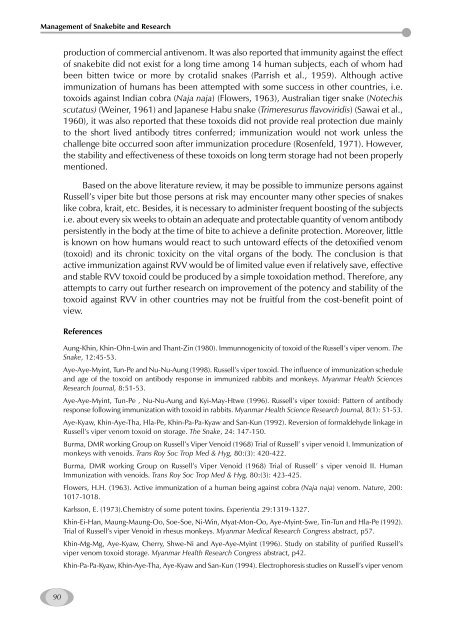Management of Snakebite and Research Management of Snakebite ...
Management of Snakebite and Research Management of Snakebite ...
Management of Snakebite and Research Management of Snakebite ...
Create successful ePaper yourself
Turn your PDF publications into a flip-book with our unique Google optimized e-Paper software.
<strong>Management</strong> <strong>of</strong> <strong>Snakebite</strong> <strong>and</strong> <strong>Research</strong><br />
90<br />
production <strong>of</strong> commercial antivenom. It was also reported that immunity against the effect<br />
<strong>of</strong> snakebite did not exist for a long time among 14 human subjects, each <strong>of</strong> whom had<br />
been bitten twice or more by crotalid snakes (Parrish et al., 1959). Although active<br />
immunization <strong>of</strong> humans has been attempted with some success in other countries, i.e.<br />
toxoids against Indian cobra (Naja naja) (Flowers, 1963), Australian tiger snake (Notechis<br />
scutatus) (Weiner, 1961) <strong>and</strong> Japanese Habu snake (Trimeresurus flavoviridis) (Sawai et al.,<br />
1960), it was also reported that these toxoids did not provide real protection due mainly<br />
to the short lived antibody titres conferred; immunization would not work unless the<br />
challenge bite occurred soon after immunization procedure (Rosenfeld, 1971). However,<br />
the stability <strong>and</strong> effectiveness <strong>of</strong> these toxoids on long term storage had not been properly<br />
mentioned.<br />
Based on the above literature review, it may be possible to immunize persons against<br />
Russell’s viper bite but those persons at risk may encounter many other species <strong>of</strong> snakes<br />
like cobra, krait, etc. Besides, it is necessary to administer frequent boosting <strong>of</strong> the subjects<br />
i.e. about every six weeks to obtain an adequate <strong>and</strong> protectable quantity <strong>of</strong> venom antibody<br />
persistently in the body at the time <strong>of</strong> bite to achieve a definite protection. Moreover, little<br />
is known on how humans would react to such untoward effects <strong>of</strong> the detoxified venom<br />
(toxoid) <strong>and</strong> its chronic toxicity on the vital organs <strong>of</strong> the body. The conclusion is that<br />
active immunization against RVV would be <strong>of</strong> limited value even if relatively save, effective<br />
<strong>and</strong> stable RVV toxoid could be produced by a simple toxoidation method. Therefore, any<br />
attempts to carry out further research on improvement <strong>of</strong> the potency <strong>and</strong> stability <strong>of</strong> the<br />
toxoid against RVV in other countries may not be fruitful from the cost-benefit point <strong>of</strong><br />
view.<br />
References<br />
Aung-Khin, Khin-Ohn-Lwin <strong>and</strong> Thant-Zin (1980). Immunnogenicity <strong>of</strong> toxoid <strong>of</strong> the Russell’s viper venom. The<br />
Snake, 12:45-53.<br />
Aye-Aye-Myint, Tun-Pe <strong>and</strong> Nu-Nu-Aung (1998). Russell’s viper toxoid. The influence <strong>of</strong> immunization schedule<br />
<strong>and</strong> age <strong>of</strong> the toxoid on antibody response in immunized rabbits <strong>and</strong> monkeys. Myanmar Health Sciences<br />
<strong>Research</strong> Journal, 8:51-53.<br />
Aye-Aye-Myint, Tun-Pe , Nu-Nu-Aung <strong>and</strong> Kyi-May-Htwe (1996). Russell’s viper toxoid: Pattern <strong>of</strong> antibody<br />
response following immunization with toxoid in rabbits. Myanmar Health Science <strong>Research</strong> Journal, 8(1): 51-53.<br />
Aye-Kyaw, Khin-Aye-Tha, Hla-Pe, Khin-Pa-Pa-Kyaw <strong>and</strong> San-Kun (1992). Reversion <strong>of</strong> formaldehyde linkage in<br />
Russell’s viper venom toxoid on storage. The Snake, 24: 147-150.<br />
Burma, DMR working Group on Russell’s Viper Venoid (1968) Trial <strong>of</strong> Russell’ s viper venoid I. Immunization <strong>of</strong><br />
monkeys with venoids. Trans Roy Soc Trop Med & Hyg, 80:(3): 420-422.<br />
Burma, DMR working Group on Russell’s Viper Venoid (1968) Trial <strong>of</strong> Russell’ s viper venoid II. Human<br />
Immunization with venoids. Trans Roy Soc Trop Med & Hyg, 80:(3): 423-425.<br />
Flowers, H.H. (1963). Active immunization <strong>of</strong> a human being against cobra (Naja naja) venom. Nature, 200:<br />
1017-1018.<br />
Karlsson, E. (1973).Chemistry <strong>of</strong> some potent toxins. Experientia 29:1319-1327.<br />
Khin-Ei-Han, Maung-Maung-Oo, Soe-Soe, Ni-Win, Myat-Mon-Oo, Aye-Myint-Swe, Tin-Tun <strong>and</strong> Hla-Pe (1992).<br />
Trial <strong>of</strong> Russell’s viper Venoid in rhesus monkeys. Myanmar Medical <strong>Research</strong> Congress abstract, p57.<br />
Khin-Mg-Mg, Aye-Kyaw, Cherry, Shwe-Ni <strong>and</strong> Aye-Aye-Myint (1996). Study on stability <strong>of</strong> purified Russell’s<br />
viper venom toxoid storage. Myanmar Health <strong>Research</strong> Congress abstract, p42.<br />
Khin-Pa-Pa-Kyaw, Khin-Aye-Tha, Aye-Kyaw <strong>and</strong> San-Kun (1994). Electrophoresis studies on Russell’s viper venom









